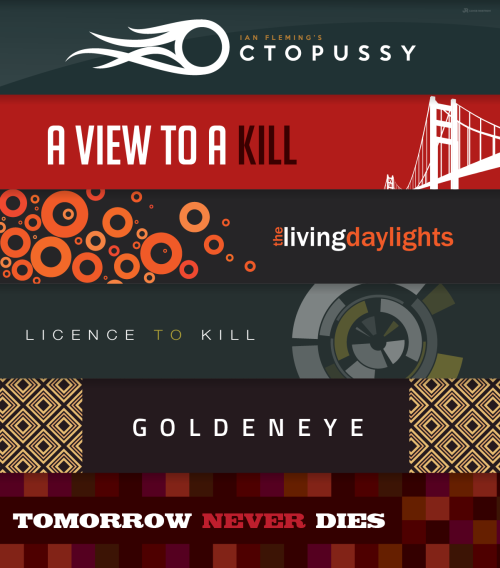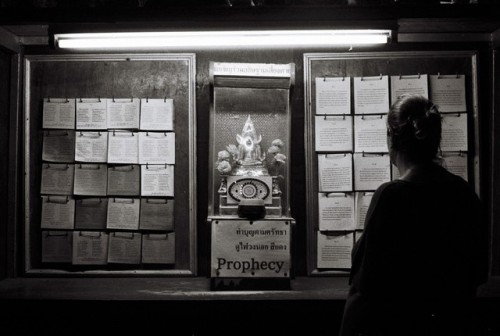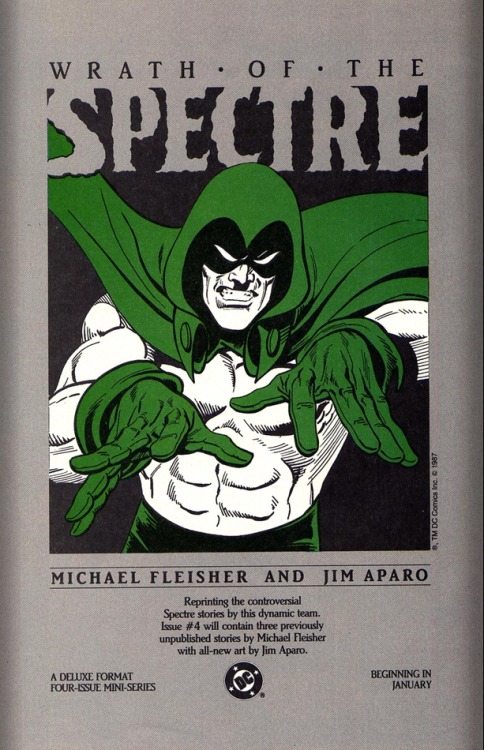#spectre
In January of 1977, I turned ten-years-old. And around that time, I would up getting my second book collection of vintage comic book stories–a book that, up until that point I didn’t even know existed. We found it in the remaindered section at Two Guys, a regional low-rent department store chain, kind of like the K-Mart of its day. And because I had money that had been given to me for my birthday, I was able to buy it. By that point, it was twelve years old and had gone through several printings–it was, in fact, the very first collection of vintage comic book stories ever published, coming out in 1965 just ahead of the Batman TV show craze.
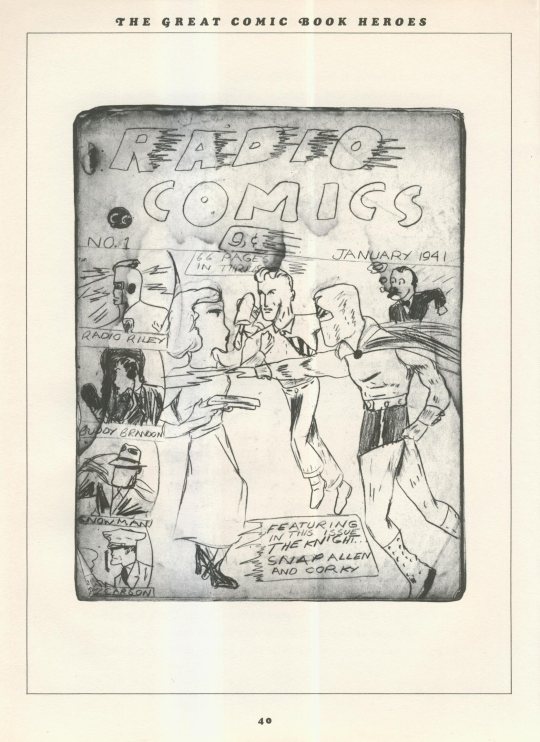
THE GREAT COMIC BOOK HEROES began life as an article that Jules Feiffer had written for Playboy magazine, of all places. It was a nostalgic look back, warts and all, at the comic books that were a part of his youth and the state of the industry a few years later when he was able to get into the business working for Will Eisner. From there, Feiffer went on to be a successful syndicated cartoonist, his strip primarily appearing in the Village Voice, as well as an accomplished playwright. He was so well-regarded, in fact, that he was able to convince a number of publishers to reprint stories from their back catalog in this hardcover collection–publishers who, up to this point, has never really worked in concert before.
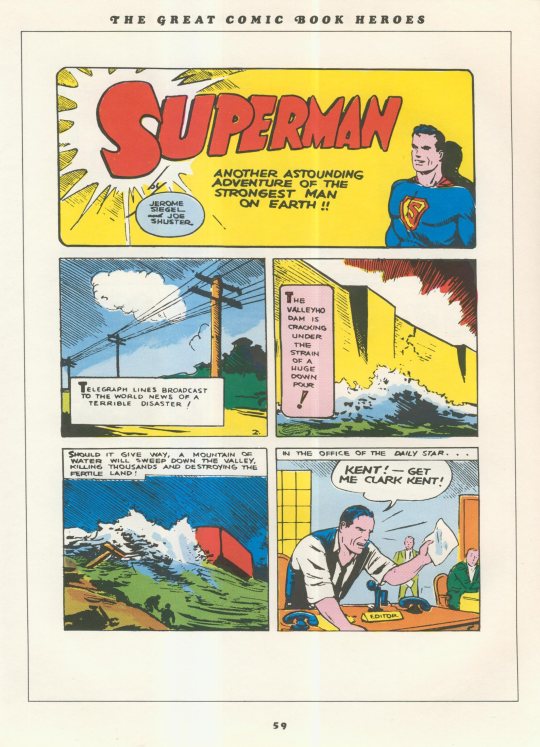
As no good reproduction materials existed, Feiffer worked in concert with DC’s Jack Adler to pioneered a process by which old comic books could be photographed under certain conditions to create a usable black line image, and then recolored. This same process was later used on many of DC’s reprints, in particular the FAMOUS 1st EDITION treasuries–I gather that the reason its use wasn’t more widespread is that it was more costly and time-consuming than was considered worthwhile for a regular comic book release.

Feiffer was also enough of a bigwig in 1965 that he was able to negotiate a minor detente in the legal agreement between DC/national Periodicals and Fawcett Publications, enough to allow him to reprint a single page’s worth of Captain Marvel. In 1977 when I read this book, I didn’t understand why this was a big deal (and in fact I had read this same story twice before already.) I believe it was the one and only exception ever granted, at least up until the point where DC began licensing the rights to Captain Marvel from Fawcett in 1973.
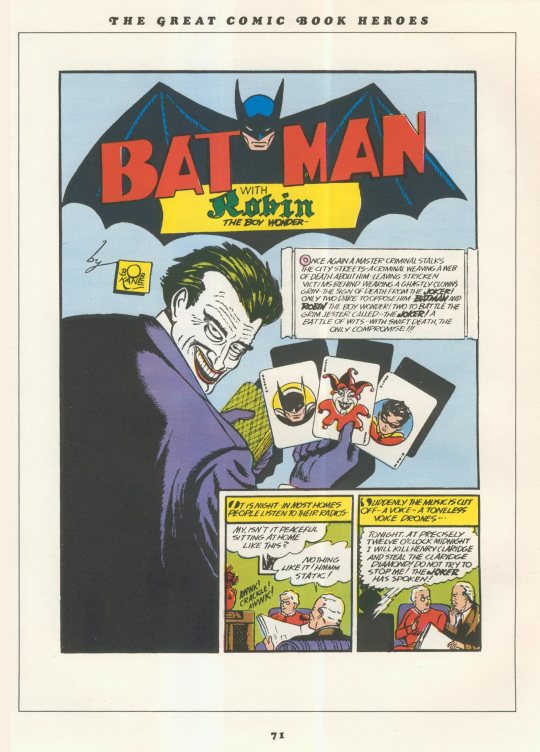
I will confess that, when I first bought this volume, I didn’t read any of Feiffer’s text. That seemed like work to me, who needed it? It was the stories that I was here for! I was hypnotized by the reproduction of one of the comic books that Feiffer had made and sold on the neighborhood street when he was a kid. I had begun to make my own comic books before this, and so this was a very primal point of connection for me–I think I may have read the text of just that one “chapter” (they were all short enough that they were only three or four pages long.)
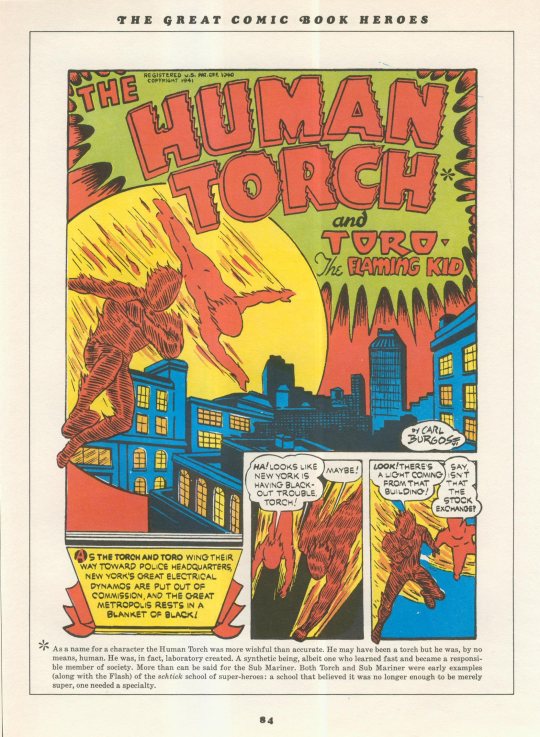
I also didn’t read the stories featuring the Human Torch, the Sub-Mariner and Captain America that were included in the volume. Why would I? I had learned from past experience that I adamantly disliked Marvel comics, decried them whenever I was asked about them, so there was no need to investigate these stories. It would literally be months, not until the summer of 1977, when, on one dull day with nothing better to do, I finally cracked and read through both Feiffer’s full text and the three Marvel stories. And they (along with the write-ups on Timely in the Steranko History of Comics, coming soon) were enough to compel me to give Marvel another chance. But we’ll get to that in due time.
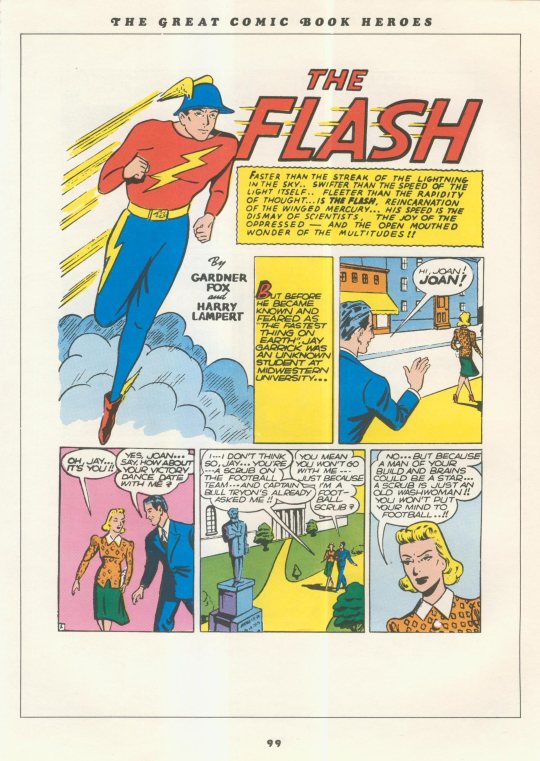
The one disappointing aspect of Feiffer’s book to me, coming to it twelve years later, is that there were already a number of stories in it that I’d read already. Because Feiffer tried to hit all of the mainstays of the big comic book houses in his reprints, and as often as possible, the opening or origin installments. The only times he varied from this approach was when there was some other aspect of the character or the strip that he was trying to highlight–a number of these series took a little while to completely crystallize in their final forms, and Feiffer took that into account when choosing his stories.
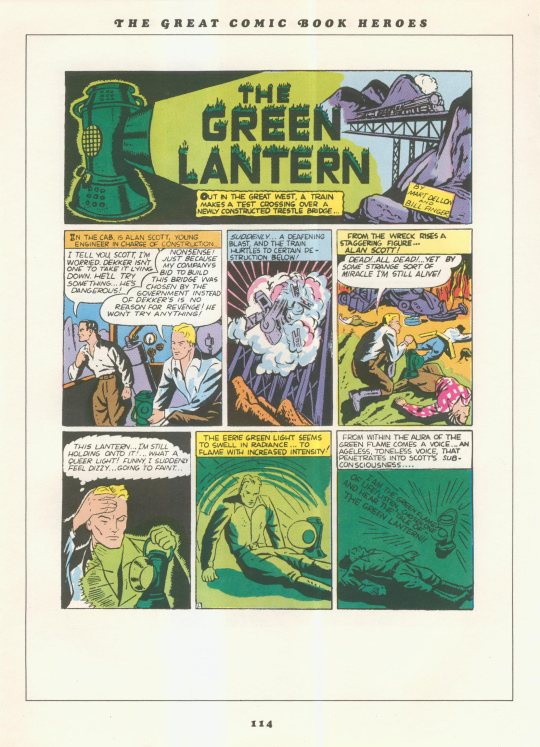
So what was reprinted in this volume? It opened with a two-page origin of Superman, taken not from ACTION COMICS #1 but rather from the more expanded version first shown in SUPERMAN #1. Thereafter, he ran a story that he sourced from SUPERMAN #3 but which was first published in ACTION COMICS #5. It’s really the first full story in which all of the quintessential elements of the Superman series coalesce: the Lois-Clark-Superman relationship in particular. There are several pages in the middle of it that were clearly reworked from newspaper strip samples, panels extended and reformatted into comic book pages haphazardly.

Following the single page of Captain Marvel he could show, Feiffer then reprints the origin of Batman, from BATMAN #1 (which I’d read), as well as the first story featuring the Joker (likewise). This was about a year in, by which point Robin had been introduced, and wit the debut of the Joker all of the elements were in place. But not new to me. Next was a relatively late Human Torch story from MARVEL MYSTERY COMICS #20–like Batman, by this point the Torch’s young partner Toro had come into the series, and it had settled down into typical super-heroics. But I didn’t read it, not yet.

A pair of stories that I’d already experienced came next: the first adventure of the Flash (my third copy of it!) from FLASH COMICS #1 and the first installment of Green lantern from ALL-AMERICAN COMICS #16. Next came a solo Spectre story from ALL-STAR COMICS #1. I was familiar with this early version of the Spectre from the FAMOUS 1st EDITION reprint of ALL-STAR #3, but he wasn’t especially interesting to me. Because he was already dead and could do literally anything, there wasn’t a lot of drama to be found in his stories. Even as a kid, this deficit was apparent to me. Superman, at least, had to struggle to accomplish whatever his goal was.
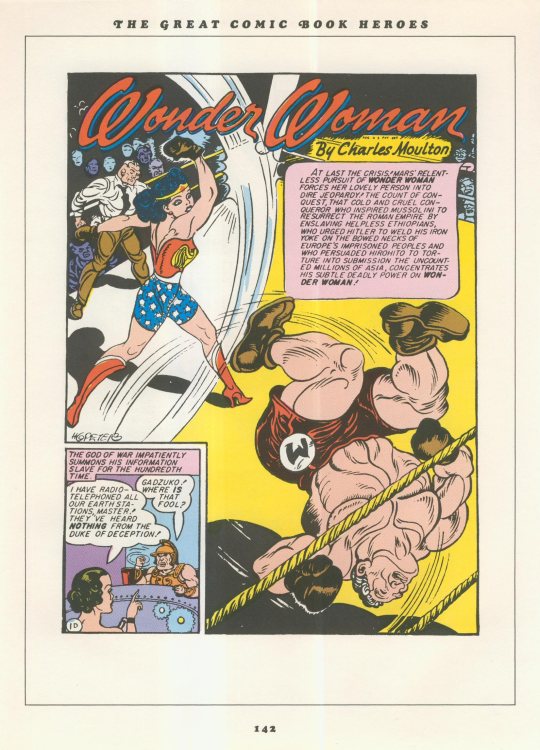
Next came an adventure of Hawkman, sourced from FLASH COMICS #5. Here, Feiffer skipped the earliest adventures of the winged wonder so as to showcase the work of Shelly Moldoff on the strip (and in particular how often he was swiping Flash Gordon panels by Alex Raymond, which happened everywhere.) This was followed by a Wonder Woman story from WONDER WOMAN #2–actually, it was a single chapter of a four-chapter larger story, but I wouldn’t discover this for decades. Feiffer chose it as a good example of some of the strange sexuality that was operating under the hood of what at first glance appeared to be a patriotic heroine series. This was the stuff that really made Wonder Woman sizzle, and the lack of which one of the reasons why her series had such a lack of pop in the 60s and 70s.

Then came a Sub-Mariner adventure from MARVEL MYSTERY COMICS #7, by which point creator Bill Everett had worked out the bugs. I didn’t read it for several months, but essentially it’s an orgy of destruction, as Namor returns to Manhattan to carve out vengeance for his undersea race by wrecking and destroying his way across the city–he even at one point accosts Mayor Fiorello LaGuardia. There isn’t much plot, only carnage–and it ends with Namor’s friend Berry Dean warning him that the Human Torch would be on his trail. But that historic meeting wasn’t included.
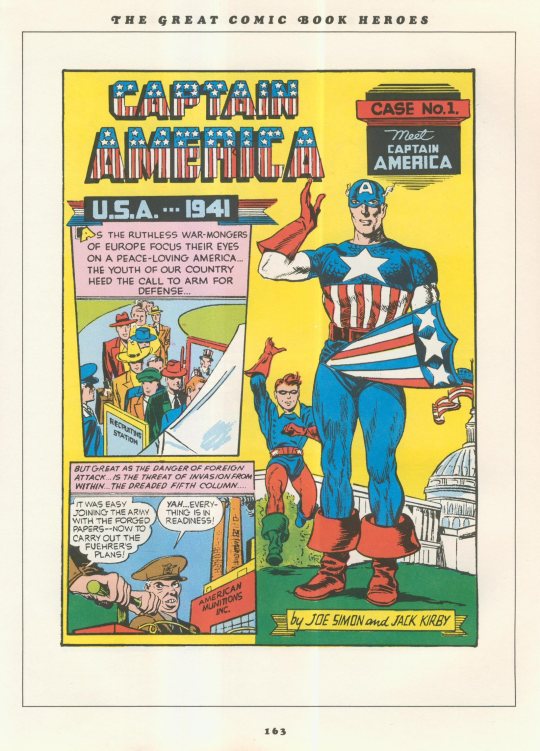
I also skipped the origin of Captain America, from CAPTAIN AMERICA COMICS #1. It’s a pretty crude piece of work, like most of what was reprinted in this volume. There are only hints of the explosiveness that Jack Kirby would bring to the comic book page in the next few issues, to say nothing of the next few decades. The pages were a little bit more jigsaw puzzle-y, but only a little bit. That would change as Kirby got going on Cap.

Next came the first Plastic Man adventure, from POLICE COMICS #1, and which I’d read a few weeks earlier in SECRET ORIGINS OF THE SUPER DC HEROES. It was still a fun tale, but one that only hinted at the inventiveness that Jack Cole would bring to the character and to the page. I felt the same way about the Spirit based on the story that Feiffer reprinted here. He spent a lot of time talking up how innovative and impressive a series it was, but from this sampling, I just couldn’t see it. Part of that, no doubt, is that most scholars consider the best period of Eisner’s Spirit to run from around 1946-1950 or so. But Feiffer was working for Eisner for most of that period–he wrote several of the most memorable tales–and so his interest was in the earliest Spirit adventures, the ones he read as a kid.
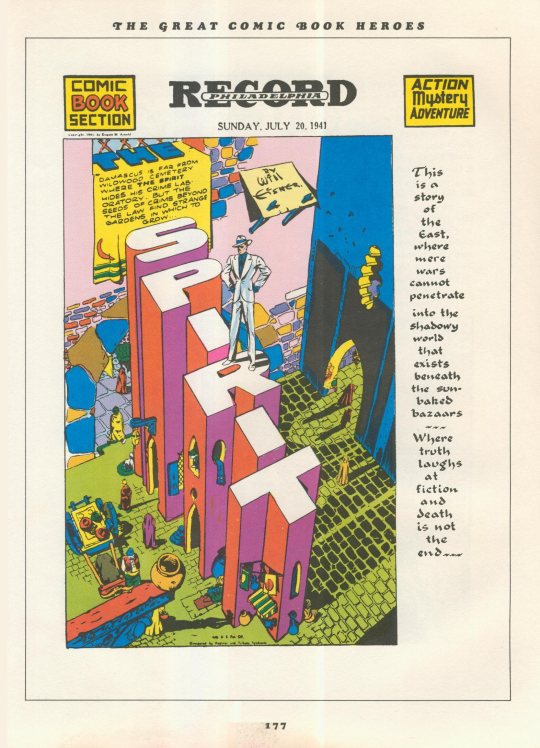
So it was a highly-enjoyable volume, and one that would have a greater impact on me over the course of time, but also slightly disappointing. But I was glad to have it, in particular because its existence came as a total surprise to me. At this point in time, there were precious few compilations of old comic book stories, so each one was like a treasured gem.
Post link
Updated version on my James Bond post: All 24 films in chronological order represented by its own graphical rectangle
Post link

Let’s see, the latest installment has: Daniel Craig Monica Bellucci Christoph Waltz and is again directed by Sam Mendes. Dis gon be gud y’all!
Wrath of The Spectremini-series
In 1988, based on the renewed popularity the Spectre was receiving thanks to his 1987 ongoing series written by Doug Moench, DC comics decided to reprint the Spectre’s ‘controversial’ stories that ran during 1974-1975 in Adventure Comics.Wrath of the Spectre reprints Spectre stories from Adventure Comics #431 to #440 and three additional Spectre stories (that never saw print) in a 4-issue deluxe format mini-series. The creative team responsible for the Adventure Comics Spectre stories were Michael Fleisher(writer),Russell Carley (art continuity), Jim Aparo(art),Frank Thorne (art) and Joe Orlando (editor). These stories were considered controversial as editor Joe Orlando was trying to push the limits of the Comics Code as far as he could.
A little bit of context: The Comics Code Authority was formed in 1954 as an indirect reaction to a book by Fredric WerthamcalledSeduction of the Innocent which claimed that scenes of graphic violence, sex, and drug use within comic books encouraged similar behavior on impressionable youths. During the late 1940s and early 1950s it was not uncommon for a comic book to have scenes of graphic violence (real or implied) since horror and crime comics dominated the comic book market. One of the comic book companies to be hit the hardest was EC Comics (known for classic horror and crime titles such as Tales of the Crypt,Vault of Horror,The Haunt of FearandCrime SuspenStories).EC Comics went down in a blaze of glory and fought tooth-and-nail to print the material they deemed fit - Comics Code Authority be damned. EC Comics eventually went bankrupt and was sold to DC Comics. Why is this relevant? Because Orlando’s comic book career (first as a penciller and then as an editor) started at EC Comics. You see, Orlando had vast experience working with horror titles (ex: EC Comics,Warren, and Atlas comics) and while Spectre wasn’t a horror character per se - it sure seemed that way based on his original stories.
The Spectre was created by Jerry SiegelandBernard Baily and first debuted in National Allied Publications’ More Fun comics #52 (1940). It was speculated that Siegel, who also co-created Superman prior to creating the Spectre, was influenced by the success of Gil KaneandBill Finger’s Batman (published in 1939) and decided to create a darker, grimmer super-hero. When the Spectre first debuted, he was the ghost of a slain cop whose modus operandi was to hunt down murderous criminals and mete out brutal supernatural vengeance. Additionally, the Spectre also fought other mystic beings that were just as powerful as he was. The Spectre was popular enough to become a chartered member of the Justice Society of America in All Star Comics #3 (1940), and then suddenly the Spectre stories were toned down drastically - starting with the introduction of Spectre’s new bumbling sidekick in 1941: Percival Popp the Super-Cop. Once DC realized that the introduction of sidekicks helped sales of a book (ex: Batman and Robin), nearly every DC hero was assigned one. Unfortunately, the Spectre was relegated to keeping his bumbling sidekick out of harm’s way - which pretty much killed the eerie supernatural tone of the series first established by Siegel. The mid-1940’s were not kind to super hero comics as their popularity had waned and other genres of comic books (ex: war, western, science fiction, romance, crime and horror) had become the big sellers. The Spectre was last seen in All-Star Comics #23 (1945) before he slipped into 'comic book limbo’.
Fun Fact: The Spectre story in More Fun Comics #52 had the first appearance of DC’s version of God in the story.
Gardner FoxandMurphy Anderson revived the Spectre in 1966, thanks to the guidance of editor Julius Schwartz who had been systematically reviving and updating all Golden Age heroes (ex: Flash, Green Lantern, the Atom, Hawkman, etc) for a new generation of comic book readers. This newly introduced Spectre was a watered-down version of the original, who now apprehended villains and delivered them to the police instead of slaying them. Furthermore, this new Spectre really played up the “battling powerful cosmic villains” aspect of the Spectre mythos.
In 1972, under the direction of editor Joe Orlando (who was also editor for DC’s House of Mystery), Adventure Comics was gradually shifting from the superhero genre to the supernatural/fantasy adventure genre. By this point the Comics Code Authority has loosened it’s censorship and horror comics were able to get away with more - which is why the market was suddenly flooded with horror titles again. Orlando was experienced with horror comics and it was a genre he was familiar with, he just needed a superhero he could feature in Adventure Comics who could also be played as a horror character - enter the Spectre.Fleisher was chosen as the writer for the Spectre based on his previous experience writing horror/suspense stories and his knowledge of Golden Age DC characters (Fleisher researched and wrote all 3 volumes of The Encyclopedia of Comic Books Heroes).Fleisher was insistent on capturing the original 'vengeful’ essence of the character (as introduced in the early Jerry Siegel stories) rather than the cosmic champion he was portrayed as during the 1960s in the Gardner Foxstories.
The reason this series was so controversial (at the time) was because the audience of the 1970s were not accustomed to super heroes killing villains. The only other Spectre stories the audience would’ve been familiar with were the Gardener Fox stories of the mid-to-late 1960s in which the Spectre conformed to the “super heroes never kill” rule. It may not be the fact that the Spectre killed criminals that was so appalling, but the manner in which he did it (ex: turn them to wax and have them melted, turned to wood and hacked up with an ax, etc) and the fact that it seemed like the Spectre took pleasure in it. In truth, the creative team was actively trying to recreate the spirit of the EC horror comics of the 1940s, but the comic readers of the 1970s probably would not have been aware of that. Joe Orlando was researching the Comics Code, finding out what he was not allowed to do, and then doing it anyways thanks to some loophole in the Comic Code guidelines (you’ll notice that all of the Adventure Comics issues featuring the Spectre have the Comics Code Authority seal on them). A few readers wrote in to state that they were uneasy with the idea of a super-hero delivering vengeful justice, and a new reporter-type character who represented their views on the Spectre was introduced to the series. The most notable thing about this controversy, however, is that most of the outcry against this series came from within the comic book industry - fan-oriented writers and assistant editors were upset that a super hero character was getting the horror treatment and boldly stated that Orlando,Fleisher and crew were ruining the “American Super-hero”. It was rumored that a combination of DC’s apprehension towards the “controversial” content of the series and dwindling sales were the reasons the feature was cancelled and replaced with an Aquaman feature instead (Adventure Comics #441).
I really enjoyed this reprint series. The coloring is absolutely beautiful and brings Jim Aparo’s illustrations a lot justice. I don’t think anyone can do swooping and swirling capes quite likeAparo. I always liked the Spectre, but only knew of him from whatever I read during All-Star Squadron, so I never really understood his powers as they were never fully explained. Is he omnipotent? Just how powerful is he? This reprint series didn’t answer any of these questions, as he seems to be invulnerable and can’t be harmed by anything. The stories all kind of followed the same formula: a murder/crime is committed, detective Jim Corrigan is on the case, the Spectre catches up to the killers and they meet a gruesome supernatural death at the hands of the Spectre. The stories were pretty self-contained - very much the same approach you’d find in a horror anthology comic. The last three unpublished stories started adding continuity, and that seemed like a step in the right direction.
Post link
Reposted from @pop.ize @Pop.ize X @nathrosfunkos present: Kingdom Come, one of DC Comics’ most memorable and influential storylines featuring art from the legendary Alex Ross and unforgettable writing from Mark Waid.
Today, we bring you the full line! Of course, the comic itself has countless characters but alas, we are but two artists. Hope you’ve enjoyed this collaboration!
Would you be down for this classic comic pop line? Comment down below!
@serlentpops
@funkopopsnews
@pop.holmes
@dccomics
@thealexrossart
@waidmark
@comicbook
#popize #popized #nathrosfunkos #originalfunko #funkofunatic #funkopop #custompop #digitalart #funko #customfunko #customfunkopop #popconcept #funkoconceptart #funkopopvinyls #funkoshareday #funkopopconcept #funkopopart #funkopopvinyl #conceptpop #funkoaddict #spectre #superman #batman #theflash #wonderwoman #kingdomcome #dccomics #alexross
https://www.instagram.com/p/CdRDd5orGVO/?igshid=NGJjMDIxMWI=
Post link




